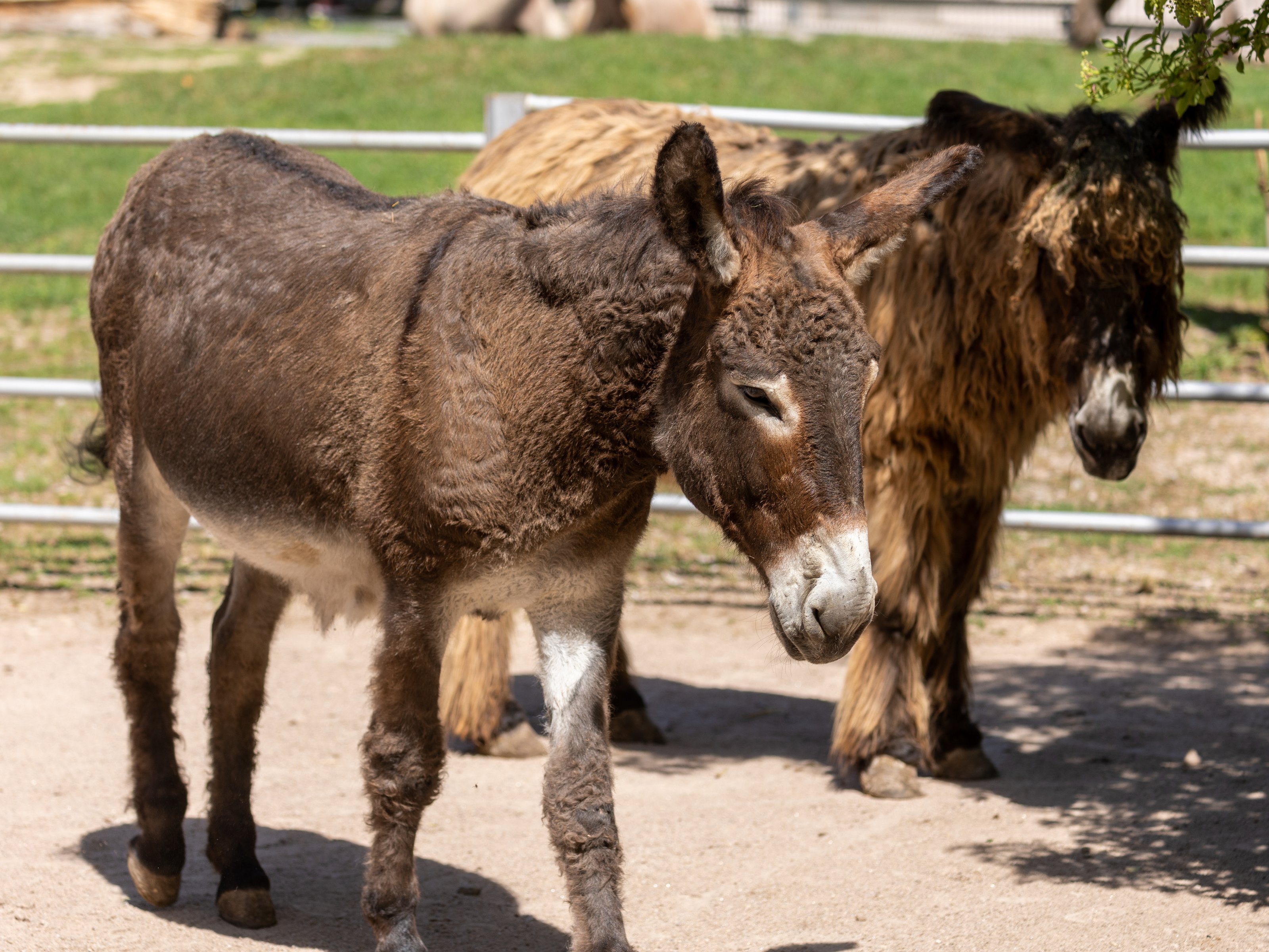
Station 21 Poitou-Esel
Niemand möchte als der größte Esel bezeichnet werden. Der Poitou ist nur einer der ganz großen Eselrassen, aber mit Sicherheit der schwerste von allen. Nun gut, unsere Tiere vielleicht nicht, da sie nicht reinrassig sind und deshalb womöglich auch nicht so groß gewachsen sind. Dafür können sie mit ihren lauten „Ihh—Aaa—Rufen“ die ganze Stadt beschallen.
Charakteristisch ist auf jeden Fall auch ihr Fell.
Oftmals bilden sich aus diesem zum Teil recht zottigen Fell richtige Fellmatten .
Der Poitouesel wurde im 10 Jahrhundert erstmals in Frankreich erwähnt. Dort wird heute auch das Zuchtbuch geführt. Vor allem in den Jahren vor dem ersten Weltkrieg wurde der Poitouesel zur Maultierzucht verwendet. Dies sind belastbare, trittsichere und gut händelbare Kreuzungen zwischen Pferd und Esel. Jetzt gibt es diese Rasse nur noch in der Hobbyhaltung und durch die vielen Einkreuzungen sind richtig reinrassige Tiere nur selten zu sehen. Leider sind unsere Tiere wegen einer Stoffwechselstörung sehr empfindlich gegenüber jeglicher Zufütterung. Daher die Tiere bitte mit gar nichts füttern. Aus besagtem Grund verzichtet der Tiergarten Falkenstein auch auf weitere Nachzuchten.
Station 21 Osel poitouský
Nikdo nechce být nazýván největším oslem. Poitou je pouze jedním z velmi velkých plemen oslů, ale rozhodně nejtěžším ze všech. No, možná tomu tak není u našich oslů, protože nejsou čistokrevní, a proto pravděpodobně nejsou tak velcí. Na druhou stranu dokáží svým hlasitým „i-há“ naplnit celé město.
V každém případě je pro ně charakteristická i srst.
Často tato někdy dosti chundelatá srst tvoří skutečné kožešinové rohože.
První zmínka o oslu z Poitou pochází z 10. století. Plemenná kniha je tam vedena i dnes. Zejména v letech před první světovou válkou byl osel z Poitou využíván k chovu mul. Jsou to odolní, jistí a snadno ovladatelní kříženci koně a osla. V současnosti se toto plemeno chová pouze jako zájmová činnost a vzhledem k velkému množství kříženců jsou skutečně čistokrevná zvířata k vidění jen zřídka. Naše zvířata jsou bohužel kvůli metabolické poruše velmi citlivá na jakékoli přikrmování. Proto je prosím nekrmte vůbec ničím. Ze stejného důvodu se Zoo Falkenstein rozhodla, že už další potomstvo odchovávat nebude.
Station 21 Poitou donkey
No one wants to be called the biggest donkey. The Poitou is only one of the very large donkey breeds, but certainly the heaviest of them all. Well, maybe not our animals, because they are not purebred and therefore possibly not grown so big. In return, they can make the whole city resound with their loud “hee-haw” calls.
In any case, their fur is also characteristic.
Often, this partly quite ragged fur forms real fur mats.
The Poitou donkey was first mentioned in France in the 10th century. Today, also the studbook is kept there. Especially in the years before the First World War, the Poitou donkey was used for mule breeding. These are resilient, sure-footed and easily manageable crosses between horse and donkey. Now this breed only exists in hobby keeping and due to the many crossbreeds, truly purebred animals are rarely seen. Unfortunately, our animals are very sensitive to any supplemental feeding due to a metabolic disorder. Therefore, please do not feed the animals with anything. For the same reason, the Falkenstein Zoo does not breed any more offspring.